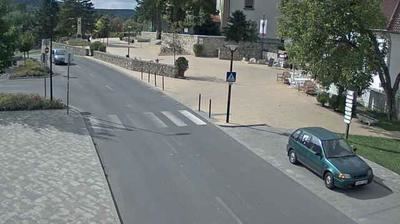Time zone CET (UTC+1) Website www.nagykovacsi.hu Local time Monday 2:58 AM | County Pest Postal code 2094 Area 14.14 km² Area code 26 | |
 | ||
Weather 7°C, Wind NW at 10 km/h, 96% Humidity | ||
Nagykovácsi (whose name in English translates as "Great Smithy") is a small town in the Pilisvörösvári kistérség district of Hungary situated some 15 km (9 mi) north-east of the centre of Budapest, in a valley, at an altitude of 340 metres. It is located next to the second district of Budapest. According to the 2011 census, its population was given as 7095, though this figure does not include the many people who own a property there as a second residence. The town is known for the natural beauty of its surrounding hills and forests and many parts of the nearby forest have been designated conservation areas—Budai Tájvédelmi Körzet (the "Buda Land Protection Area")—in order to protect several rare species of flora growing there. Its location has contributed to the town's development in the last 20 years and today it is a popular place in which to live. The American International School of Budapest chose Nagykovácsi as the site for its new campus in 2000.
Contents
Map of Nagykov%C3%A1csi, Hungary
History
Archaeological finds indicate that this region has been inhabited since prehistory. Objects found in the caves of the Remete ravine and along the banks of Ördög indicate that people lived there during the Ice, Iron, and Stone ages. Various tools, coins and fragments of stone statues unearthed in the area show that there were inhabitants, too, under the Roman Empire. Of these stone fragments, the most interesting were embedded in the wall of the local church when it was built.
In medieval records, Nagykovácsi is referred to as Koachi and Kowachy. These names indicate that royal smiths viz. ironsmiths (kovács) lived in the town.
The first local document still in existence, a deed of gift, dates from 1254. During the Turkish occupation in Hungary, in the middle of the 16th century, the village suffered much destruction and the population fell sharply. Once the Turks had been driven out, the Habsburg family who reigned in Hungary invited Swabian colonists to settle in Kovácsi (1700–1760). These newcomers were skilful stockbreeders and farmers and also built three quarries, a coal-mine and two lime kilns.
Many of the German-speaking population of the town were forcibly resettled after the Second World War and new inhabitants arrived from the Hungarian Great Plains (Alföld), the parts of Upper Hungary (Felvidék) (today in Slovakia), and from Budapest to take their place.
The manor house in Nagykovácsi was built in first half of the 19th century by the local Teleki family. Thereafter the property passed into the hands of the Tisza family and today it is known still as the Tisza Manor. Originally the children of Hungarian foresters received regular school teaching in this well-preserved building. The idea of gathering such children into an educational establishment was gradually recognized throughout Europe as an excellent initiative and attracted interested visitors from many countries. At the end of the Second World War, the manor was confiscated and from 1958 it served as an agricultural college. It is thought that in 1989 the property, which needed renovation, was offered to the local council for the nominal sum of one Hungarian Forint. The latter did not take up the offer. Ownership of the property was passed to the Scout Movement in 2013.
Today local townspeople make every effort to protect local sights, amongst these the statue of the Virgin Mary in the church and a memorial to the fallen of both world wars.
